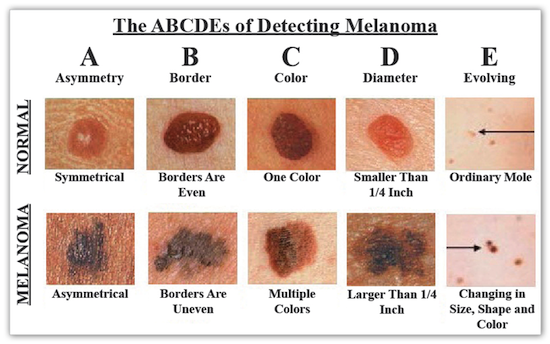
6 Signs That May Indicate Skin Cancer. Don’t Ignore These
Edited By: Stephanie Dawson
Skin cancer can occur on any part of the skin. The most cancer prone areas of our skin are those which are most exposed to the sun like neck, face, and hands. Moles or dark patches on the skin that are flat or slightly raised are generally harmless, however if the mole changes in shape, color, and/or size it may be a sign of skin cancer.
Skin is made up of two layers, epidermis and dermis. The upper layer of skin, epidermis, contains three types of cells squamous, basal, and melanocytes.
There are a variety of skin cancer symptoms, which include changes to the skin that do not heal, discolored skin, and changes in moles around the edges and enlargement.

Basal cell carcinoma
A basal cell carcinoma is a tumor that is generally present as a raised, smooth, and pearly bump on parts of the body that are exposed to the sun. Sometimes small blood vessels also become visible inside the tumor. Crusting and bleeding frequently takes place in the center of the tumor. This form of skin cancer is the least deadly and can be cured easily without much difficulty.

Squamous cell carcinoma
If you have a red, scaling, thick patch on exposed parts of skin it may be an indicator of skin cancer. It can appear on head, neck, or shoulders as well. These may be firm hard nodules shaped like a dome. Bleeding and ulceration may also occur. If not treated properly, it develops into a large mass. This is the second most common type and is dangerous if ignored.
Melanoma
The most dangerous type of skin cancer. It consists of various colors which range from brown to black. It is important to keep the ABCDE of melanoma in mind.
Asymmetry
Asymmetry, the two halves of the mole do not match.
Border
If the edges of a mole are irregular, jagged, or blurred
Color
If the color of a mole is uneven and has more than one shade bring it to your doctor’s notice
Diameter
A mole wider than 6mm in diameter, the size of a pencil eraser
Evolution
The growth of moles takes place over time, melanocytic growth is often observed over a period of time. Its a good idea to take photographs of any suspicious marks using a ruler or coin for comparison.
ABCDE is a guideline for monitoring changes to the skin, visit your doctor if you see any abnormal patches on your skin or any Signs That May
Indicate Skin Cancer








